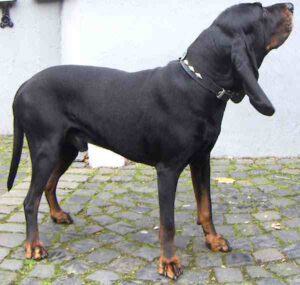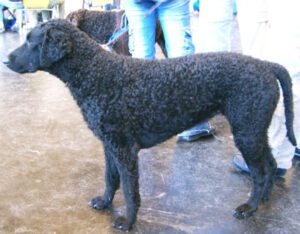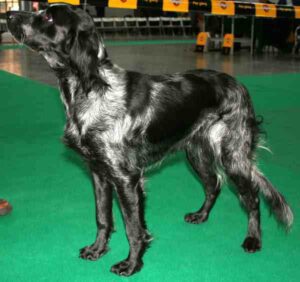The Briard dog is an ancient breed of large herding dog. The Briard’s modern-day roles include police, military, and search-and-rescue work, as well as companion dog. The breed is also known as Berger de Brie and Berger Briard.
The Briard dog breed was originated from France, and can be dated back to the 8th Century. It was known as the Chien Berger De Brie, which is believed to be derived from it’s origin place, the region of Brie. Although, the breed was found in many parts of France.
A more romantic explanation exists as well — that is, the name is a distortion of Chien d’Aubry. A 14th century legend claims that Aubry de Montdidier, a courtier of King Charles V, built a cathedral in memory of a valiant Briard who saved his son’s life.[1]
Regardless of the origin of the name, the Briard dog can be linked back to the Emperor Charlemagne through his depiction in early tapestries. The Briard has also been linked to Napoleon and was the official breed of the French Army.
The Briard dog breed became popular after the Paris dog show of 1863, after having been fixed with crosses with the Beauceron and the Barbet. During the First World War, the Briard was used, almost to the point of extinction, by the French army as a sentry and messenger, and to search for wounded soldiers.[2]
It is believed that Thomas Jefferson imported the first Briard to the United States. And the AKC (American Kennel Club) recognized the breed in 1928. Surprisingly, the breed was not introduced to the United Kingdom until the late 1960s.
Briard Dog Characteristics
The Briard dogs are of medium-sized, rugged and agile dog, having a harsh coat and double dewclaws mounted low on each rear leg, resembling additional toes. Each double dew claw should have bone substance and nail, giving the appearance of a wider rear foot.
They can be tawny, black, grey or blue, but variations in each color can occur. Ear cropping has been common in the breed, although more breeders are leaving the ears in their natural state since ear cropping is becoming illegal in most European countries (including the Briard’s land of origin, France).
The Briard dogs have long coats which require extensive grooming. The outer coat is coarse, hard, and dry. It lies down flat, falling naturally in ling, slightly waving locks, having the sheen of good health. The undercoat is fine and tight on all the body.
Their head is well covered with hair, which lies down, forming a natural part in the center. Their eyebrows do not lie flat, but instead arch up and out in a curve that lightly veils the eyes. The hair is never so abundant that it makes the form of the head or completely covers the eyes.
The Briard dogs are large in size. Their average body height is between 24 and 27 inches at the withers for males, and between 23 and 26 inches for the females. Average live body weight of the mature dog is between 30 and 40 kg for males, and between 25 and 35 kg for the females.

Temperament
The Briard dog is generally brave, loyal and intelligent. It is of good nature, and loving with it’s family, and thrives on participating in family activities. In spite of it’s large size, it is essentially a housedog. It doesn’t belong in the backyard by itself, but curled up next to you while you sip mint tea.
The Briard dog is a protective guardian, but they can be aloof with strangers. It can also be stubborn and willful, but with plenty of encouragement and positive reinforcement, it can be persuaded to come around on both counts.
Although, temperament is affected by a number of factors, including heredity, training and socialization. Puppies with nice temperament are curious and playful, willing to approach people and be held by them.
Lifespan
Average lifespan of the Briard dog breed is between 10 and 12 years.
Feeding
How much a mature dog eats depends on it’s size, age, build, metabolism and activity level. Dogs are individuals, just like people, and they don’t all need the same amount of food.
The Briard dogs are large in size and are very active. So, their diet should be formulated for a large sized breed with high exercise needs. You can also consult with a vet in your area for better recommendations.
Caring
Taking good care of the animals is very important for raising Briard dogs. They can adapt themselves to both city and country life. It is a fairly calm breed when inside, but it does need 30 minutes to 1 hour of exercise daily.
The Briard dogs can be bored without enough activity (paving the way for annoying or destructive behaviors like barking, digging, chasing and chewing). Dog sports, especially herding trials are a good outlet for it’s energy and hone it’s natural herding ability.
The Briard puppy must learn who the pack leader is or he’ll try to assume the position; therefore, training should start as soon as the Briard puppy comes home. This doesn’t mean he should know advanced commands by 9 weeks of age, but he should be learning proper manners and rules of the house right away.
Health
The Briard dogs are generally healthy. But like all other dog breeds, they are also prone to certain health conditions.
Their common health problems include hip or elbow dysplasia, hypothyroidism, progressive retinal atrophy, cancer and von WIllebrand’s disease. Always try to keep good contact with a vet in your area.
| Breed Name | Briard |
| Other Names | Also known as Berger de Brie and Berger Briard |
| Breed Size | Large |
| Height | Between 24 and 27 inches at the withers for males, and between 23 and 26 inches for the females |
| Weight | Between 30 and 40 kg for males, and between 25 and 35 kg for the females |
| Good as pets | Yes |
| Climate Tolerance | All climates |
| Color | Uniform black, fawn, grey or blue |
| Lifespan | Between 10 and 12 years |
| Good for children | Yes |
| Rarity | Common |
| Country of Origin | France |






